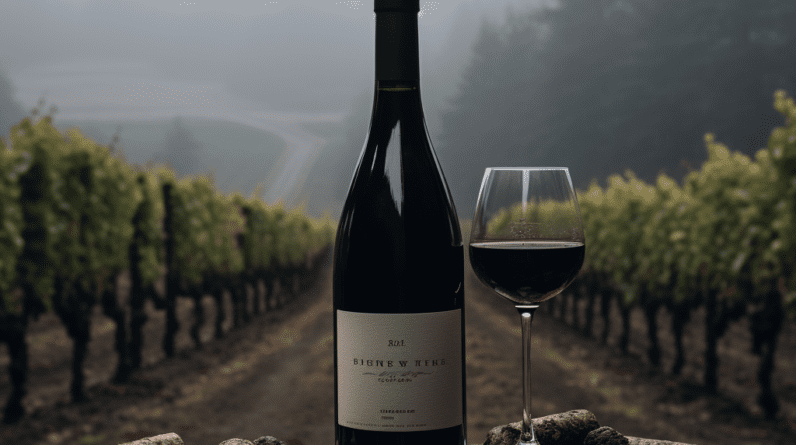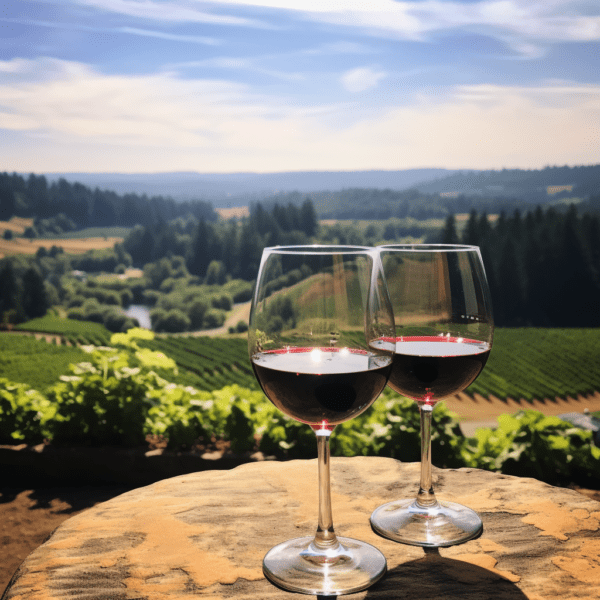
The World of Oregon Pinot Noir
Oregon’s Pinot Noir is more than just a wine; it’s a narrative of meticulous craftsmanship and distinctive terroir.
As we delve into the world of these award-winning wines, we uncover the essence of what makes them so sought-after by connoisseurs and casual drinkers alike.

Understanding the Unique Appeal of Oregon Pinot Noir
The secret to Oregon Pinot Noir’s allure lies in its harmonious blend of flavor, aroma, and texture.
Grown predominantly in the Willamette Valley, the grapes benefit from a climate that mirrors the famous Pinot regions of France.
Cool, foggy mornings and warm, sunny afternoons create the perfect conditions for Pinot Noir, resulting in wines with a delicate complexity and an elegant, silky finish.
Aromatics and Flavor Profile
Fruit Characteristics
Oregon Pinot Noir typically exhibits a spectrum of red fruit flavors, such as raspberry, cherry, and cranberry.
Unlike some bolder Pinots from warmer regions, these fruit notes tend to be more subtle and nuanced.
Earthy and Floral Notes
A hallmark of Oregon Pinot is its earthy undertones, which might remind one of fallen leaves or damp soil, complemented by floral notes like rose petal and violet.
Spice and Minerality
Many of these wines carry a hint of spice – think of light touches of cinnamon or clove – and a distinct minerality that adds to their complexity.
Structure and Mouthfeel
Acidity
Oregon’s cooler climate contributes to higher acidity levels in its Pinot Noir, lending a crisp, refreshing quality that balances the fruit flavors.
Tannins
The tannins are typically moderate, contributing to a smooth and velvety mouthfeel without being overly aggressive.
Body
These wines are generally medium-bodied, striking a balance between lightness and depth, making them versatile and food-friendly.
Aging Potential
Oregon Pinot Noirs, especially from good vintages, have a noteworthy aging potential.
Over time, the primary fruit flavors evolve into more complex, secondary flavors like mushroom, leather, and earth, adding to the wine’s depth and character.
Influence of Climate and Terroir
The varied microclimates and soils across different Oregon AVAs (American Viticultural Areas), such as the Willamette Valley, Umpqua Valley, and others, contribute to slight variations in the
flavor profiles of the Pinot Noirs.
For instance, wines from cooler areas might exhibit more pronounced acidity and floral notes, while those from warmer parts might have riper fruit flavors.
Winemaking Techniques
Winemakers in Oregon often employ both traditional and innovative techniques, influencing the final profile of the wine.
This includes decisions on fermentation methods, aging (in oak or stainless steel), and blending practices.
In summary, Oregon Pinot Noir is revered for its elegant balance of fruit, earthiness, and spice, coupled with a structure that allows it to age gracefully.
These wines reflect the diverse landscapes and climatic conditions of Oregon, showcasing the skill and artistry of its winemakers.
They are a testament to the state’s ability to produce world-class wines that can stand alongside the best from more established Pinot Noir regions.

Why and How Do They Make Award-Winning Pinot Noir in Oregon?
The status of Oregon Pinot Noir as award-winning and internationally recognized is rooted in several key factors that combine to create exceptional wines.
These factors contribute not only to the quality of the wines but also to their reputation and success in competitions and among critics.
Unique Terroir and Climate
Oregon, especially the Willamette Valley, has a climate and soil composition that is particularly well-suited for Pinot Noir.
The cool climate, influenced by the Pacific Ocean, ensures a longer growing season, which is crucial for developing complex flavors and balanced acidity in the grapes.
The diverse soils, including volcanic and sedimentary, contribute distinct mineral qualities to the wine.
Skilled Winemaking
Oregon has attracted and nurtured talented winemakers who combine traditional methods with innovative techniques.
They focus on quality over quantity, often handpicking grapes and using gentle winemaking processes to preserve the delicate flavors and aromas of Pinot Noir.
Many winemakers also adopt sustainable and organic practices, which are increasingly valued in the wine world.
Artisanal Approach and Attention to Detail
A significant number of Oregon wineries are small-scale, artisanal operations where attention to detail is paramount.
This artisanal approach allows for more experimentation and meticulous control over the winemaking process, leading to high-quality, distinctive wines.
Aging Potential
Oregon Pinot Noirs are known for their ability to age gracefully.
As they mature, they develop more complex flavor profiles, which is a highly regarded characteristic in the wine community and contributes to their success in competitions.
Distinctive Style
Oregon Pinot Noir often strikes a balance between the fruit-forward style of California and the earthy, mineral-driven style of Burgundy.
This unique profile appeals to a wide range of palates and has helped Oregon carve out a niche in the global wine market.
Community and Collaboration
The Oregon wine community is known for its collaborative spirit.
Winemakers share knowledge, research, and techniques, fostering an environment of continuous improvement and innovation.
This collective growth mindset has propelled the overall quality of the region’s wines.
International Recognition
Recognition in international competitions, reviews from esteemed wine critics, and features in prestigious publications have all contributed to the award-winning status of Oregon Pinot Noir.
Success in these arenas has helped to build a strong reputation on the global stage.
In essence, the combination of Oregon’s conducive terroir, skilled and innovative winemaking, and a community-focused approach to viticulture and enology has led to the creation of exceptional,
award-winning Pinot Noirs that are celebrated both nationally and internationally.

Exploring Top Vineyards
Willamette Valley Vineyards
Sustainable Viticulture
Willamette Valley Vineyards is deeply committed to sustainable farming practices.
They are certified sustainable through LIVE (Low Input Viticulture and Enology) and Salmon-Safe.
This dedication extends across various vineyard locations, including their Estate Vineyard in the Salem Hills, Tualatin Estate Vineyard in Forest Grove, Elton Vineyard in the Eola-Amity Hills, and
Bernau Estate Vineyard in Dundee.
Founding and Recognition
Founded in 1983 by Oregon native Jim Bernau, Willamette Valley Vineyards started with the dream of creating world-class Pinot Noir.
Over time, this vision has transformed the winery into one of the region’s leading names, even earning the title “One of America’s Great Pinot Noir Producers” from Wine Enthusiast Magazine.
Erath Winery
Pioneering History
Erath Winery, established by Dick Erath, is one of the pioneering wineries for Pinot Noir in Oregon.
Dick Erath, undeterred by the region’s cool climate, sought to find the ideal home for Burgundian grapes, most notably Pinot Noir, in Oregon.
The region’s similarity to France’s Burgundy was a key factor in this endeavor.
Erath planted its first Pinot Noir grapes in the Dundee Hills in 1969, marking the beginning of an era that would see Oregon Pinot Noirs gain world-class acclaim.
Throughout the 1980s, the Oregon wine industry blossomed significantly, partly thanks to the efforts of wineries like Erath.
Domaine Drouhin Oregon
French Tradition Meets Oregon Terroir
Domaine Drouhin Oregon represents the fusion of generations of French winemaking tradition with the adventurous spirit of American viticulture.
The Drouhin family, renowned in Burgundy, was one of the first major international wine entities to recognize and invest in the potential of Oregon for producing high-quality Pinot Noir and
Chardonnay.
The winery was established when the Drouhin family purchased land in the Dundee Hills in 1987.
This decision followed over a century of experience in winemaking in Burgundy.
The family’s expertise quickly turned their Oregon venture into a respected winery, now producing around 30,000 cases annually from their estate vineyards.
Innovative Vineyard Practices
Domaine Drouhin Oregon adopted tightly spaced Burgundian vine spacing to increase competition and minimize fruit yield per vine.
This practice, though challenging for farming, ensures high-quality grapes.
They even imported specialized equipment from France to manage these tightly spaced vineyards.
Unique Terroir and Winemaking Approach
The vineyard is located on an east-facing hillside, benefiting from direct morning sun exposure.
The soil, known locally as Jory, is of volcanic origin with high iron content, ideal for producing high-quality wine grapes.
In the cellar, Domaine Drouhin Oregon blends traditional Burgundian methods with innovative techniques.
They were among the first in the region to build a gravity flow winery and typically use about 20% new oak for aging their Pinot Noir.
Their Chardonnay is also made with minimal new oak influence, focusing on expressing the natural fruit and earth characteristics.
Each of these vineyards has made significant contributions to the reputation and quality of Oregon Pinot Noir, blending their unique approaches to viticulture and winemaking with the distinctive
terroir of the region.

| Vineyard | Description | Best Wines |
|---|---|---|
| Domaine Drouhin | Known for smooth finish, slightly acidic, with notes of dried cherry, blackberry, oak, and leather. | Domaine Drouhin Pinot Noir (2016 Vintage)
|
| Elouan | Mellow taste with undertones of cherry, strawberry, red plum, earthy and oak notes. | Elouan Pinot Noir
|
| Firesteed
| Best-selling with flavors of strawberry, raspberry, mushroom, truffle, and floral notes. | Firesteed Pinot Noir Willamette Valley (2016 Vintage) |
| Willamette Valley Vineyards
| Fruity taste with strawberry, raspberry, earthy notes of mushroom and truffle. | Willamette Valley Vineyards Whole Cluster Pinot Noir |
| The Four Graces
| Light to medium body, fruity with strawberry, raspberry, herbal notes, black pepper. | The Four Graces Pinot Noir |
| Lemelson Vineyards
| Smooth with notes of red cherries, cranberries, cocoa, forest floor, pepper, licorice. | Lemelson Vineyards Thea’s Selection Pinot Noir (2013 Vintage) |
| Penner-Ash
| Cherry-like taste with floral, cedar, tannins, tobacco, chocolate, rhubarb, tomato, gooseberry notes. | Penner-Ash Pinot Noir (2015 Vintage) |
| Shea Wine Cellars
| High acidity, smooth finish with cherry, chocolate, vanilla, prune, raisin, and other dry fruits. | Shea Wine Cellars Estate Pinot Noir |
| Beaux Frères
| Sophisticated taste with cherries, pepper, cinnamon, licorice, spiced pear, prunes, raisins. | Beaux Frères The Beaux Frères Vineyard Pinot Noir (2015 Vintage) |
| Alexana Winery
| Dry, slightly acidic, smooth finish with cherry, raspberry, vanilla, earthy notes. | Alexana Revana Vineyard Estate Pinot Noir (2016 Vintage) |
These vineyards are renowned for their exceptional Pinot Noirs, each offering unique flavor profiles and characteristics that showcase the diversity and quality of Oregon’s wine production.

Exceptional vintages of Oregon Pinot Noir are those years when the weather conditions and other factors combine to produce wines of outstanding quality.
Some vintages stand out for their balance, complexity, and aging potential.
Here are a few notable ones, along with reasons why they are exceptional.
2008
Why Exceptional: The 2008 vintage in Oregon is often celebrated for its exceptional quality.
A cooler growing season resulted in a longer hang time for grapes, enhancing flavor development while maintaining acidity.
Characteristics: These Pinot Noirs are known for their complexity, finesse, and great aging potential.
2012
Why Exceptional: 2012 was a standout year in Oregon due to near-perfect weather conditions.
The growing season was marked by a warm, dry summer, leading to an excellent harvest.
The grapes achieved optimal ripeness, resulting in wines with great structure, depth, and potential for aging.
Characteristics: Wines from this vintage typically exhibit rich fruit flavors, balanced acidity, and robust tannins.
2014
Why Exceptional: Marked by a warm growing season, 2014 produced an abundant crop with ripe and healthy grapes.
The wines from this year are noted for their approachability and fruit-forward character.
Characteristics: The 2014 vintage is characterized by its ripe fruit flavors and smooth tannins, making them enjoyable in their youth while still holding potential for aging.
2015
Why Exceptional: This vintage was characterized by one of the earliest starts to the growing season, followed by a hot summer.
These conditions led to an early harvest, producing wines with ripe fruit flavors and considerable concentration.
Characteristics: The 2015 Pinot Noirs are known for their richness, depth of flavor, and a velvety texture.
2018
Why Exceptional: The 2018 vintage is notable for its consistency and the excellent quality of the grapes.
The growing season was relatively long and even, without extreme heat, allowing for gradual ripening and flavor development.
Characteristics: Wines from 2018 are distinguished by their balance, elegance, and aromatic complexity.
In summary, exceptional vintages in Oregon are often the result of favorable climatic conditions that allow for optimal grape ripening and health.
These vintages produce wines that not only reflect the character of Oregon Pinot Noir but also stand out for their balance, depth, and potential for development over time.
Expert Tasting Tips
Serving
Achieve the perfect tasting experience by serving these Pinots at about 55-60°F.
This temperature range unlocks their aromatic potential without overpowering the delicate flavors.
Decanting
Especially for the younger vintages, decanting can significantly enhance the wine’s complexity.
Even 30 minutes of aeration can make a noticeable difference.
Ideal Food Pairings
The versatility of Oregon Pinot Noir makes it a delight to pair with food.
It goes exceptionally well with the earthy flavors of truffles or wild mushrooms, complements the richness of duck and pork, and can even be paired with spicier dishes due to its fruit-forward
nature.

Visiting and Experiencing the Vineyards
A trip to these vineyards isn’t just about wine tasting; it’s an educational journey.
Many offer guided tours where you can learn about their unique winemaking processes, sustainable practices, and get a firsthand look at the art of viticulture.
Wine tourism in Oregon, particularly in regions known for producing Pinot Noir, has become an integral part of the state’s appeal.
This area offers a unique and enriching experience for visitors, ranging from casual wine enthusiasts to seasoned connoisseurs.
Here are some key aspects of wine tourism in Oregon’s wine country.
Diverse Wine Regions
While the Willamette Valley is the most renowned for its Pinot Noir, other regions like Southern Oregon, the Columbia Gorge, and the Walla Walla Valley also offer unique wine experiences.
Each region has its distinct climate, terroir, and varietal specialties.
Boutique and Family-Owned Wineries
Oregon is home to many small, family-owned wineries that offer a personal and intimate tasting experience.
Visitors often get the chance to meet the winemakers, learn about the winemaking process, and taste wines that aren’t widely available elsewhere.
Wine Tours and Tastings
Many wineries offer guided tours of their vineyards and facilities, along with tastings where visitors can sample a range of wines.
Some tours also provide educational insights into Oregon’s winemaking history and viticulture.
Wine Events and Festivals
Throughout the year, Oregon hosts various wine-related events and festivals.
These include Pinot Noir celebrations, barrel tasting events, and harvest festivals, offering visitors a chance to experience the local wine culture and community.
Scenic Beauty and Outdoor Activities
Oregon’s wine country is not only about wine; it’s also known for its stunning landscapes, including rolling hills, lush valleys, and picturesque vineyards.
Many visitors combine wine tours with outdoor activities like hiking, cycling, or picnicking among the vines.
Culinary Experiences
The wine regions of Oregon are also celebrated for their culinary offerings.
Many wineries have on-site restaurants or tasting rooms that pair local wines with regional cuisine, emphasizing fresh, locally-sourced ingredients.
Accommodations
From cozy bed and breakfasts nestled in vineyards to luxurious boutique hotels, the region offers a range of accommodations.
Staying in wine country allows visitors to fully immerse themselves in the tranquil and scenic environment.
Accessibility and Hospitality
Oregon’s wine country is known for its welcoming and unpretentious atmosphere.
The region is easily accessible, with many wineries located within a short drive from Portland, making it an ideal destination for both day trips and longer stays.
| Type | Name | Location | Features |
|---|---|---|---|
| Accommodation | The Allison Inn & Spa | Newberg | Luxury resort, spa, proximity to vineyards
|
| Accommodation | Black Walnut Inn & Vineyard | Dundee | Elegant inn, vineyard views, luxury amenities
|
| Accommodation | Youngberg Hill | McMinnville | Winery and inn, stay at a working vineyard
|
| Winery with Restaurant
| King Estate Winery | Eugene | Restaurant with organic ingredients, Pinot Noir and Pinot Gris |
| Winery with Restaurant | Domaine Serene
| Dayton | Wine lounge, seasonal menu, Pinot Noirs and Chardonnays |
| Winery with Restaurant | Stoller Family Estate
| Dayton | Tasting room with food pairings, sustainable wines |
| Winery Stay
| Abbey Road Farm B&B | Carlton | B&B on a farm and winery, converted silos accommodations |
| Winery Stay | The Vintages Trailer Resort
| Dayton | Vintage trailers, picturesque setting |
In summary, wine tourism in Oregon offers a rich tapestry of experiences.
It’s not just about tasting exceptional wines but also about engaging with the local culture, enjoying the natural beauty, and discovering the passion and craft behind Oregon’s celebrated wine
industry.
In exploring Oregon’s award-winning Pinot Noirs, one doesn’t just taste a wine but experiences a story in each glass.
These vineyards and vintages invite you into a world where tradition, innovation, and a deep respect for the land come together to create something truly extraordinary.
FAQs:
Q1: What makes Oregon Pinot Noir unique?
A1: Oregon Pinot Noir is unique due to its terroir, influenced by the state’s cool climate and diverse soils.
These wines are known for their balance of fruit, earthiness, and minerality, with a subtler and more nuanced profile compared to Pinot Noirs from warmer regions.
Q2: Can you recommend some top vineyards for Oregon Pinot Noir?
A2: Notable vineyards include Domaine Drouhin, known for its Burgundian influence, Willamette Valley Vineyards for its sustainable practices, and Beaux Frères, renowned for its sophisticated
wines.
Other distinguished vineyards are Elouan, Firesteed, The Four Graces, Lemelson Vineyards, Penner-Ash, Shea Wine Cellars, and Alexana Winery.
Q3: What are some exceptional vintages of Oregon Pinot Noir?
A3: Exceptional vintages include 2012, known for its structure and aging potential; 2015, celebrated for its richness; 2018, notable for its balance and elegance; 2008, famous for its complexity;
and 2014, appreciated for its ripe fruit flavors and smooth tannins.
Q4: Why are certain vintages of Oregon Pinot Noir considered exceptional?
A4: Vintages are considered exceptional due to favorable weather conditions that allow for optimal grape ripening, leading to wines with balanced acidity, complex flavors, and suitable aging
potential.
Q5: What food pairs well with Oregon Pinot Noir?
A5: Oregon Pinot Noir pairs excellently with a variety of foods, including grilled salmon, duck, pork dishes, mushroom risotto, and even spicier cuisine, thanks to its fruit-forward nature and
balanced acidity.
Q6: Is Oregon Pinot Noir suitable for aging?
A6: Yes, many Oregon Pinot Noirs, especially from good vintages, have excellent aging potential.
Over time, they develop more complex flavor profiles, enhancing their depth and character.
Q7: What should I look for when visiting Oregon vineyards?
A7: When visiting Oregon vineyards, look for tasting opportunities, vineyard tours, and any special events or festivals.
Many vineyards also offer insights into their winemaking processes and sustainable practices.
Q8: Are there any sustainable vineyards for Oregon Pinot Noir?
A8: Yes, many Oregon vineyards, like Willamette Valley Vineyards, practice sustainable viticulture, often certified through programs like LIVE (Low Input Viticulture and Enology) and Salmon-Safe.
Q9: Can beginners enjoy Oregon Pinot Noir?
A9: Absolutely! Oregon Pinot Noir is known for its approachability and is a great starting point for those new to wine tasting, offering a range of styles from light and floral to rich and structured.
Q10: How does the climate in Oregon affect Pinot Noir production?
A10: Oregon’s cooler climate allows for a longer growing season, leading to grapes that develop complex flavors and balanced acidity, which are crucial for creating the nuanced and elegant
profile of Oregon Pinot Noir.







